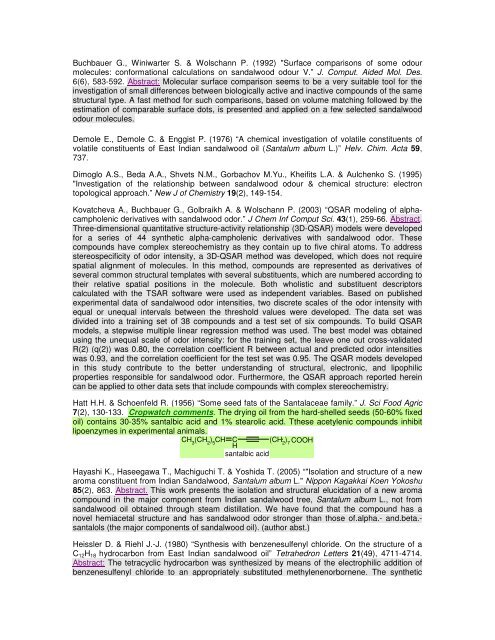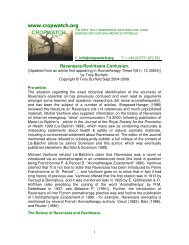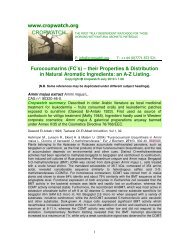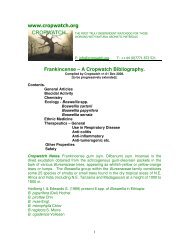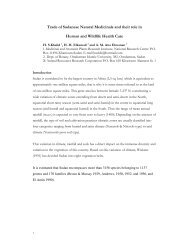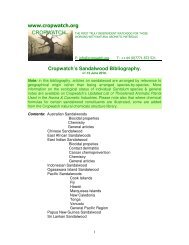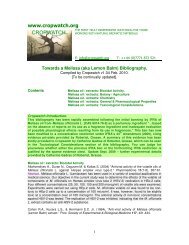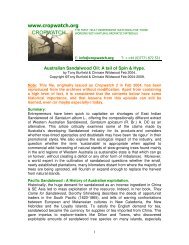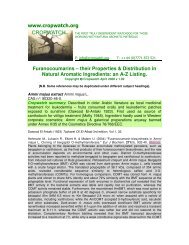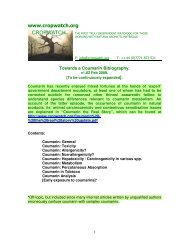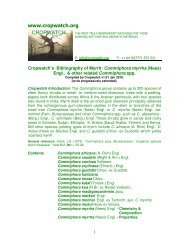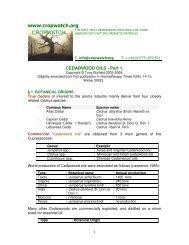Queensland Sandalwood - Cropwatch
Queensland Sandalwood - Cropwatch
Queensland Sandalwood - Cropwatch
You also want an ePaper? Increase the reach of your titles
YUMPU automatically turns print PDFs into web optimized ePapers that Google loves.
Buchbauer G., Winiwarter S. & Wolschann P. (1992) "Surface comparisons of some odour<br />
molecules: conformational calculations on sandalwood odour V.” J. Comput. Aided Mol. Des.<br />
6(6), 583-592. Abstract: Molecular surface comparison seems to be a very suitable tool for the<br />
investigation of small differences between biologically active and inactive compounds of the same<br />
structural type. A fast method for such comparisons, based on volume matching followed by the<br />
estimation of comparable surface dots, is presented and applied on a few selected sandalwood<br />
odour molecules.<br />
Demole E., Demole C. & Enggist P. (1976) “A chemical investigation of volatile constituents of<br />
volatile constituents of East Indian sandalwood oil (Santalum album L.)” Helv. Chim. Acta 59,<br />
737.<br />
Dimoglo A.S., Beda A.A., Shvets N.M., Gorbachov M.Yu., Kheifits L.A. & Aulchenko S. (1995)<br />
"Investigation of the relationship between sandalwood odour & chemical structure: electron<br />
topological approach.” New J of Chemistry 19(2), 149-154.<br />
Kovatcheva A., Buchbauer G., Golbraikh A. & Wolschann P. (2003) “QSAR modeling of alphacampholenic<br />
derivatives with sandalwood odor.” J Chem Inf Comput Sci. 43(1), 259-66. Abstract.<br />
Three-dimensional quantitative structure-activity relationship (3D-QSAR) models were developed<br />
for a series of 44 synthetic alpha-campholenic derivatives with sandalwood odor. These<br />
compounds have complex stereochemistry as they contain up to five chiral atoms. To address<br />
stereospecificity of odor intensity, a 3D-QSAR method was developed, which does not require<br />
spatial alignment of molecules. In this method, compounds are represented as derivatives of<br />
several common structural templates with several substituents, which are numbered according to<br />
their relative spatial positions in the molecule. Both wholistic and substituent descriptors<br />
calculated with the TSAR software were used as independent variables. Based on published<br />
experimental data of sandalwood odor intensities, two discrete scales of the odor intensity with<br />
equal or unequal intervals between the threshold values were developed. The data set was<br />
divided into a training set of 38 compounds and a test set of six compounds. To build QSAR<br />
models, a stepwise multiple linear regression method was used. The best model was obtained<br />
using the unequal scale of odor intensity: for the training set, the leave one out cross-validated<br />
R(2) (q(2)) was 0.80, the correlation coefficient R between actual and predicted odor intensities<br />
was 0.93, and the correlation coefficient for the test set was 0.95. The QSAR models developed<br />
in this study contribute to the better understanding of structural, electronic, and lipophilic<br />
properties responsible for sandalwood odor. Furthermore, the QSAR approach reported herein<br />
can be applied to other data sets that include compounds with complex stereochemistry.<br />
Hatt H.H. & Schoenfeld R. (1956) “Some seed fats of the Santalaceae family.” J. Sci Food Agric<br />
7(2), 130-133. <strong>Cropwatch</strong> comments. The drying oil from the hard-shelled seeds (50-60% fixed<br />
oil) contains 30-35% santalbic acid and 1% stearolic acid. Tthese acetylenic compounds inhibit<br />
lipoenzymes in experimental animals.<br />
CH 3<br />
(CH 2<br />
) 5<br />
CH C<br />
H<br />
(CH 2<br />
) 7<br />
COOH<br />
santalbic acid<br />
Hayashi K., Haseegawa T., Machiguchi T. & Yoshida T. (2005) “"Isolation and structure of a new<br />
aroma constituent from Indian <strong>Sandalwood</strong>, Santalum album L." Nippon Kagakkai Koen Yokoshu<br />
85(2), 863. Abstract. This work presents the isolation and structural elucidation of a new aroma<br />
compound in the major component from Indian sandalwood tree, Santalum album L., not from<br />
sandalwood oil obtained through steam distillation. We have found that the compound has a<br />
novel hemiacetal structure and has sandalwood odor stronger than those of.alpha.- and.beta.-<br />
santalols (the major components of sandalwood oil). (author abst.)<br />
Heissler D. & Riehl J.-J. (1980) “Synthesis with benzenesulfenyl chloride. On the structure of a<br />
C 12 H 18 hydrocarbon from East Indian sandalwood oil” Tetrahedron Letters 21(49), 4711-4714.<br />
Abstract: The tetracyclic hydrocarbon was synthesized by means of the electrophilic addition of<br />
benzenesulfenyl chloride to an appropriately substituted methylenenorbornene. The synthetic


